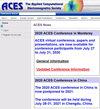The Behavior of Electromagnetic Wave Propagation in Photonic Crystals with or without a Defect
IF 0.6
4区 计算机科学
Q4 ENGINEERING, ELECTRICAL & ELECTRONIC
Applied Computational Electromagnetics Society Journal
Pub Date : 2021-08-06
DOI:10.47037/2020.aces.j.360603
引用次数: 0
Abstract
In this study, the electromagnetic wave propagation behavior of two-dimensional photonic crystal plates with a defect is investigated. For this purpose, the partial differential equation for the electromagnetic wave propagation in various photonic crystal plates containing a defect or not is obtained by using Maxwell’s equations. The defect is also defined in the electromagnetic wave propagation equation appropriately. In order to solve the electromagnetic wave propagation equation, the finite differences method is used. The material property parameters of the photonic crystal plates are determined with respect to the defects. Accordingly, the effects of material property parameters on electromagnetic wave propagation frequencies, phase velocities, and group velocities are examined. The effects of the size and position of the defects on the electromagnetic wave propagation frequencies are also discussed. The highest electromagnetic wave propagation fundamental frequency value obtained from the analyses performed is 1.198 Hz. This fundamental frequency value is obtained for the electromagnetic wave propagation in the t-shaped photonic crystal plate. Electromagnetic field distribution maps for the fundamental frequencies of the photonic crystal plates whose electromagnetic wave propagation behaviors are examined are obtained with the ANSYS package program based on the finite differences time-domain (FDTD) method.电磁波在有缺陷或无缺陷光子晶体中的传播行为
本文研究了带缺陷的二维光子晶体板的电磁波传播特性。为此,利用麦克斯韦方程组,得到了电磁波在含缺陷或不含缺陷的各种光子晶体板中传播的偏微分方程。在电磁波传播方程中也适当地定义了缺陷。为了求解电磁波传播方程,采用了有限差分法。根据缺陷确定了光子晶体板的材料性能参数。据此,考察了材料性能参数对电磁波传播频率、相速度和群速度的影响。讨论了缺陷的尺寸和位置对电磁波传播频率的影响。从所进行的分析中获得的电磁波传播基频最高值为1.198 Hz。该基频值是电磁波在t形光子晶体板中传播时的基本频率值。基于时域有限差分法(FDTD),利用ANSYS软件包程序得到了研究电磁波传播行为的光子晶体片基频的电磁场分布图。
本文章由计算机程序翻译,如有差异,请以英文原文为准。
求助全文
约1分钟内获得全文
求助全文
来源期刊
CiteScore
1.60
自引率
28.60%
发文量
75
审稿时长
9 months
期刊介绍:
The ACES Journal is devoted to the exchange of information in computational electromagnetics, to the advancement of the state of the art, and to the promotion of related technical activities. A primary objective of the information exchange is the elimination of the need to "re-invent the wheel" to solve a previously solved computational problem in electrical engineering, physics, or related fields of study.
The ACES Journal welcomes original, previously unpublished papers, relating to applied computational electromagnetics. All papers are refereed.
A unique feature of ACES Journal is the publication of unsuccessful efforts in applied computational electromagnetics. Publication of such material provides a means to discuss problem areas in electromagnetic modeling. Manuscripts representing an unsuccessful application or negative result in computational electromagnetics is considered for publication only if a reasonable expectation of success (and a reasonable effort) are reflected.
The technical activities promoted by this publication include code validation, performance analysis, and input/output standardization; code or technique optimization and error minimization; innovations in solution technique or in data input/output; identification of new applications for electromagnetics modeling codes and techniques; integration of computational electromagnetics techniques with new computer architectures; and correlation of computational parameters with physical mechanisms.

 求助内容:
求助内容: 应助结果提醒方式:
应助结果提醒方式:


